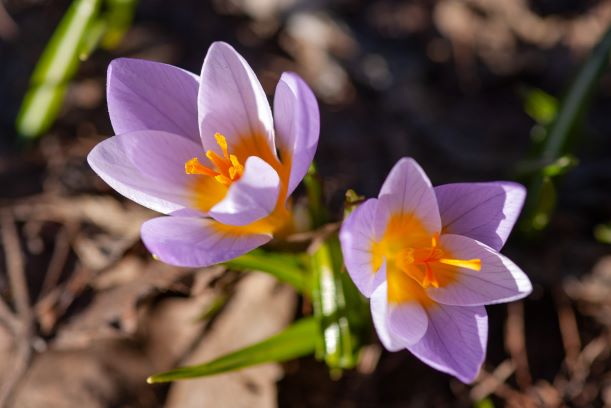The calendar has officially announced that winter is at its end and spring has arrived. On those cold days that remain, it’s often difficult to feel the presence of spring. But the beauty of the season is always there to assist us in brightening our mood and experiencing joy in the pop of color that spring flowers bring. But those spring flowers have something unusual in common with those who are mourning. Did you know that many spring flowers take their name from Greek mythology? More interesting than that, many of these stories focus on the grief and loss of heroes or gods and their creation of flowers as an act of remembrance for those they have lost.
The Crocus
One of the earliest spring flowers to appear is the crocus. This flower is known to pop its head through the breaking snow as it leads the way for other spring flowers to follow. Crocuses are known for multiplying each year with colors ranging from purple to orange, from yellow to white and everything in between. In Greek mythology, as told by the physician Galen, Crocus was a beloved companion of the god Hermes. Unfortunately, Crocus was killed accidentally by Hermes during a discus game. As Hermes mourned, he transformed Crocus’ body into a flower. Many people associate the crocus with happiness, joy and cheerfulness. It is generally recognized as a symbol of hope that the dark days of winter are at an end and that life will return and flourish.
As best said by Miss H.F. Gould in The Poetry of Flowers:
“Many, perhaps, from so simple a flower,
This little lesson may borrow,
Patient today, through its gloomiest hour,
We come out the brighter tomorrow.”
The Hyacinth

The hyacinth is a mid-spring bloom that creates a strong fragrance and flash of color that can be lavender, cobalt blue, deep purple, cream, pink and even apricot. Hyacinths also get their name from a Greek legend, the handsome hero Hyancithus. The hero was slain by the Greek god of the west wind, Zephyr. The god Apollo was so saddened that he used the hero’s
blood to create a flower, the hyacinth. Outside of Greek myths, the hyacinth made its way to Europe in the late 1500s and remained exclusively in the gardens of European royalty until the 18th century. The hyacinth represents peace, commitment and beauty. The Greeks also saw the hyacinth as a flower symbolizing power and pride. In the early Christian church, the tall, upright flower represented happiness and love. One of the most common colors, purple, has special symbolism. Purple hyacinths symbolize sorrow, forgiveness and spirituality.
The Iris

The iris is a well-known perennial flower that finds it way into many photographs and artwork. This spring bloom leaves many gardens bathed in color as they unfurl stunning flowers
that appear from spring to early summer. The petals look like tall signal flags, waving in a sea of green stalks. The name, iris, comes from the Greek word for rainbow. In fact, Iris is the goddess of the rainbow and a messenger of the Iris was even a companion to the souls of women who were on their way to heaven. The flower was used to decorate the scepters of pharaohs in Egypt as they were victorious in battle and was the inspiration for the fleur-de-lis that was used by the French monarchy. The iris is tied to many different meanings. The purple iris symbolizes royalty and wisdom, yellow symbolizes passion, white represents purity, and blue symbolizes faith and hope. In fact, the Greek people still plant purple irises on women’s graves to help them on their journey after death.
The Daffodil

Daffodils bloom in early to mid-spring and are often either a vibrant yellow or showy white. They have six petals and are known as the yellow trumpets of spring. In England, they are also called Lent lilies. Many common flowers also take their scientific name from Greekmythology. The vibrant yellow daffodil is a part of the Narcissus genus which includes the Narcissus jonquilla. Narcissus, of course, was the Greek man granted beauty from the gods. He spurned the affection of a wood nymph named Echo and left her devastated and consumed in grief. The journey didn’t end well for Narcissus, as he later looked into a shimmering lake and fell in love with his own image. As he disappeared, the fate given him by the gods, a golden flower appeared in his place. As a spring bloom, they have come to symbolize strength, fortitude and overcoming obstacles. Daffodils, throughout history, represent rebirth and new beginnings. The yellow hue symbolizes vitality, community, forgiveness and memories.
Reflecting on Flowers and
Grief
Flowers and grief have always been connected. We send flowers when someone loses a loved one. These flowers are used as a visual expression of our sympathy, grief, love and respect for the one we have lost and the family they leave behind. But the power of the simple flower is greater than that. We can see it in the common thread of the stories behind these spring blooms. All of the Greek myths above directly touch upon love and loss. Each of the flowers carries with it symbolism that turns our thoughts to the task of grief work. They encourage hope, optimism, forgiveness and remembrance. So, as the weather gets warmer, take a little time to stop and reflect. Consider doing more than just smelling the flowers.






